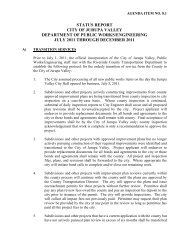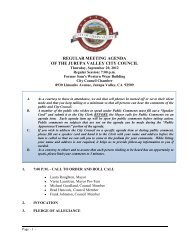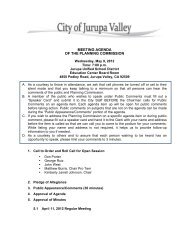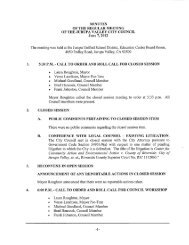Agenda Packet - City of Jurupa Valley
Agenda Packet - City of Jurupa Valley
Agenda Packet - City of Jurupa Valley
You also want an ePaper? Increase the reach of your titles
YUMPU automatically turns print PDFs into web optimized ePapers that Google loves.
Potentially<br />
Significant<br />
Impact<br />
less than less No<br />
Significant Than Impact<br />
with<br />
Significant<br />
Mitigation<br />
Impact<br />
Incorporated<br />
development in the SCAB, including the proposed Project, would cumulatively contribute to these<br />
pollutant violations.<br />
The project is consistent with the General Plan and the <strong>Jurupa</strong> Area Plan land use designations. The<br />
General Plan (2003) is a policy document that reflects the County's vision for the future <strong>of</strong> Riverside<br />
County.<br />
The General Plan is organized into eight separate elements, including an Air Quality<br />
Element. The purpose <strong>of</strong> the Air Quality Element is to protect County residents from the harmful<br />
effects <strong>of</strong> poor air quality. The Air Quality Element identifies goals, policies, and programs that are<br />
meant to balance actions regarding land use, circulation, and other issues with their potential effects<br />
on air quality. The Air Quality Element, in conjunction with local and regional air quality planning<br />
efforts, addresses ambient air quality standards set forth by the Federal Environmental Protection<br />
Agency (EPA) and the California Air Resources Board (CARB). Potential air quality impacts resulting<br />
from the proposed Project would not exceed emissions projected by the Air Quality Element. The<br />
County is charged with implementing the policies in the General Plan Air Quality Element, which are<br />
focused on reducing concentrations <strong>of</strong> criteria pollutants, reducing negative impacts to sensitive<br />
receptors, reducing mobile and stationary pollutant sources, increasing energy conservation and<br />
efficiency, improving the jobs to housing balance, and facilitating multi-jurisdictional coordination for<br />
the improvement <strong>of</strong> air quality.<br />
Implementation <strong>of</strong> the project would not impact air quality beyond the levels documented in EIR No.<br />
441 prepared for the General Plan. The project would impact air quality in the short-term during<br />
construction and in the long-term through operation. In accordance with standard county<br />
requirements, dust control measures and maintenance <strong>of</strong> construction equipment shall be utilized on<br />
the property to limit the amount <strong>of</strong> particulate matter generated. These are standard requirements and<br />
are not considered mitigation pursuant to CEQA.<br />
The proposed project would primarily impact air quality through increased automotive emissions.<br />
Single projects typically do not generate enough traffic and associated air pollutants to violate clean<br />
air standards or contribute enough air pollutants to be considered a cumulatively considerable<br />
significant impact. Operational impacts associated with the project would be expected to result in<br />
emissions <strong>of</strong> VOC, NOX, CO, PM10, PM2.5 and SOX. Operational emissions would result from<br />
vehicle emissions, fugitive dust associated with vehicle travel, combustion emissions associated with<br />
natural gas use, emission related to electricity generation, and landscape eqUipment maintenance<br />
emissions. In the long term, emissions <strong>of</strong> VOC, NOX, CO, PM10 and PM2.5 and could exceed<br />
SCAQMD significance thresholds (in pounds per day). However, with compliance with standard<br />
requirements for use <strong>of</strong> low VOC paints and compliance with California Energy Commission Title 24<br />
requirements for building energy efficiency, direct and cumulative air quality impacts would be<br />
reduced to a level below significance. These are standard requirements and are not considered<br />
mitigation pursuant to CEQA. Therefore, the impact is considered less than significant.<br />
d) A sensitive receptor is a person in the population who is particularly susceptible to health effects<br />
due to exposure to an air contaminant than is the population at large. Sensitive receptors (and the<br />
facilities that house them) in proximity to localized CO sources, toxic air contaminants or odors are <strong>of</strong><br />
particular concern. High levels <strong>of</strong> CO are associated with major traffic sources, such as freeways and<br />
major intersections, and toxic air contaminants are normally associated with manufacturing and<br />
commercial operations. Land uses considered to be sensitive receptors include long-term health care<br />
facilities, rehabilitation centers, convalescent centers, retirement homes, residences, schools,<br />
playgrounds, child care centers, and athletic facilities. Surrounding land uses include residential,<br />
Page 9 <strong>of</strong> 35 EA No. 42367











